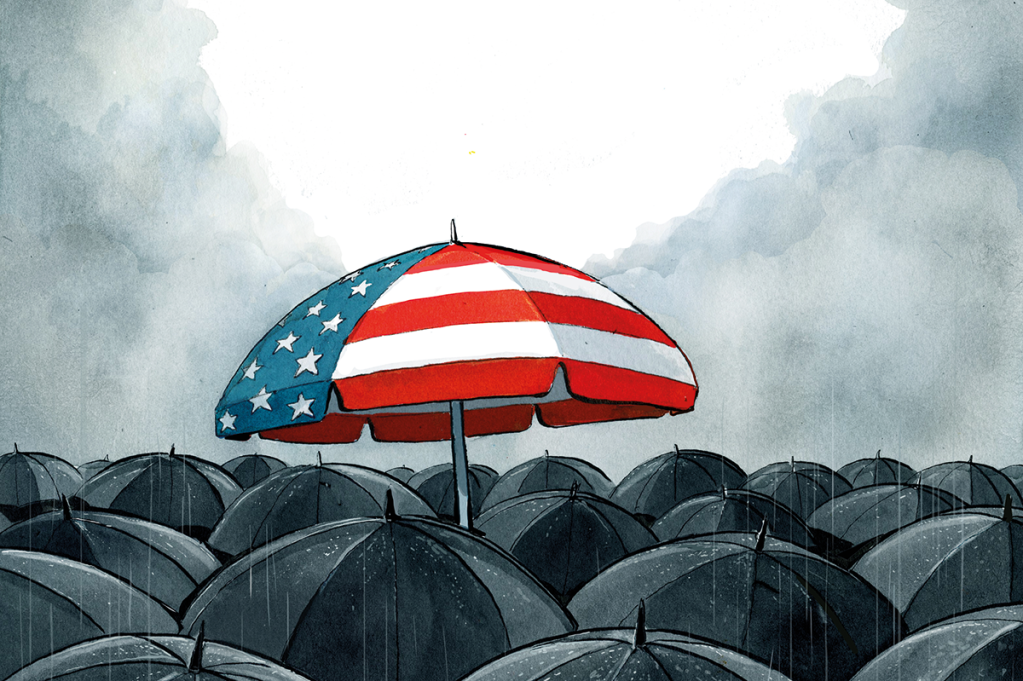What happens when progress stops? That’s an important question in a country whose self-understanding is deeply tied to the idea of progress — material, technological, political and social. America’s first three centuries were characterized by physically pushing its border across the continent, west to the Pacific and then across nearly 2,500 miles of open ocean. It would not have been obvious to early Americans that Hawaii, a tropical archipelago far away from the California coast, would become the nation’s fiftieth state, joined in a political union with the far-distant original states facing the Atlantic. While the country was expanding in size, rapid progress was made in many other areas: science and technology extended the average life span, elevated living standards and promoted social mobility and broad-based prosperity. Americans have come to expect upward movement to continue: GDP will keep rising and science will make us healthier and wealthier, while political and cultural movements will make us better, happier people.
But progress has slowed, stalled or even reversed in recent decades. Technology is still advancing, but primarily in the digital world. People get married later and have fewer children; life span stopped increasing and has actually declined in the past several years, even before the onset of Covid-19. It now takes two incomes to support a family of four in the middle class; one income was sufficient as recently as the 1980s. Self-reported levels of happiness have dropped. Social trust is diminishing and the social consensus is badly frayed. Distrust of gatekeepers is widespread. The institutions responsible for protecting and advancing the interests of the nation — political, cultural, academic — have failed in their core mission and have become self-interested to the point of sociopathy. In short, America has not been moving upward.
The uncomfortable fact is that civilizational progress doesn’t happen by some law of nature and is not guaranteed to continue indefinitely. Civilizations can rise, achieve greatness and then fade, leaving behind evidence of impressive ingenuity. To the modern mind, it is disorienting to realize that earlier civilizations could have been just as prosperous, secure and happy as our own — perhaps more so.
But the trajectory of civilization is not somehow upward by definition. Decline and decay are just as possible as progress. In fact, decay is the default: it’s what happens when you just do nothing. Political scientist Samuel P. Huntington famously argued, following a classic understanding of national cycles, that every nation is in either a state of development or decline. I would offer a modification that gets to the heart of the matter: there is an invisible force that drives development, which I call vitality.
The vitality of a nation can be judged in two ways: by the private life of its people and by its public life. In the private sphere, a nation is successful if the people are physically secure in their lives and their property; if families are being formed and are free, generally prosperous and self-sustaining; and if those families produce at least enough children to maintain a stable population. That sounds simple, because it describes the basic conditions for personal independence, physical security, social continuity and a general sense of wellbeing. Add to this a broadly shared worldview supported by religious piety and practice and one has the conditions for a vital civilization. Rome and Athens had this. America used to have it too.
In the public sphere, civilizational vitality is shown in a capacity for collective action, which is rooted in what the fourteenth-century Arab philosopher Ibn Khaldun called asabiyya. This concept can be understood as social cohesion, national or civilizational purpose, a feeling of being in it together and for the same reasons. When asabiyya is high, societies grow prosperous because high social trust supports complex trade relationships along with specialization and division of labor, allowing for innovation and the production of luxury goods.
Just as personal vitality grows from a strong sense of identity and purpose, civilizational vitality springs from a shared identity that unites people, legitimizes the state and explains its place in the world, and inspires great societal achievements. America has undertaken big projects in the past, from taming the frontier to the early space program, but our ability to accomplish great things as a nation has waned in recent decades. One reason is a fading sense of national identity and purpose.
When the frontier closed, American national identity was largely set, and the nation’s restless energy then went out into a global project — which now seems to have run its course. Will the engine that propelled this country simply burn out? The past few decades in America have been characterized by five major phenomena: globalization, financialization of the economy, science and tech stagnation (despite advances in digital technology), managerialism and risk aversion.
Taken together, these developments have brought us to a crossroads. Numerous indicators of societal health have been trending downward, often reinforcing each other. Some trends owe to factors outside our control, others resulted in part from earlier decisions that were made in good faith and would have seemed right to most smart, informed, well-intentioned people at the time. Now it’s time to reckon with those errors and correct our course.
Many one-time-only advances were made in an earlier era: discovering electricity, preventing polio and other communicable diseases, developing antibiotics. These singular advances brought great material improvements to people’s lives, and the benefits were widely distributed. Let’s look at the average American home in 1900: by the best estimate, only 1 percent of homes had indoor plumbing. There was no electric light, no refrigerator, no telephone, no washing machine, no television, no car parked outside. All these things were standard in the average American home by 1960. The typical home of 2023 wouldn’t look greatly different: the TV is probably a large flatscreen with many more channels; there are multiple phones and maybe no land line; there’s a PC or some laptops and tablets with internet. But the differences aren’t as dramatic as those between 1900 and 1960.
Things were changing fast and for the better before 1960. America was growing, people were living longer and healthier lives, and living standards were rising. There was a lot of momentum behind American expansion, and when progress slowed down it wasn’t really noticeable for a while. But science has been advancing more slowly and at greater cost, resulting in slower development of new technology that improves living standards, a slower increase in productivity, and lower real economic growth.
This is what Tyler Cowen called “the Great Stagnation” in his 2010 book. A decade later, few people seem willing to accept the idea. Acknowledging that we’re in a period of stagnation seems like a form of heresy, even if its effects are all around us: stagnant wages, a widening wealth gap, a shrinking middle class, endless cycles of debt that trap people in what economic anthropologist David Graeber called bullshit jobs — “a form of paid employment that is so completely pointless, unnecessary, or pernicious that even the employee cannot justify its existence even though, as part of the conditions of employment, the employee feels obliged to pretend that this is not the case.” Obesity and chronic inflammatory diseases have become more widespread. Loneliness and alienation have been rising since before Robert Putnam wrote Bowling Alone in 2000. Social cohesion is weaker and political polarization is sharper. Americans have even stopped having enough children to keep the population steady, let alone expand it, one consequence of which is that the median age of Americans has climbed from 28.1 in 1970 to 38.3 in 2020. As American society has grown older, it has also become more risk-averse, less willing to take on big challenges that could lead to a more prosperous future.
The main consequence of stagnation is a loss of social mobility: the promise of modern American liberalism has been that if you work hard and play by the rules, you will do better than your parents, and if you go to college, a secure place in the middle class should be a near certainty. Now each new generation is doing worse than the one before it; many find themselves running just to stand still. At every stage of life, Generation X has owned a smaller share of the national wealth than baby boomers did at the same median age, while millennials own even less.
It’s easy to see why millennials are sometimes characterized as a Lost Generation and why sociopathologies — including high rates of drug use, sexual dysfunction, depression and other mental health issues — are so much in evidence among them, along with radical politics. They are a large part of American society, but because they hold such a small share of national wealth relative to the preceding generations at their age, they are more alienated from the system and resentful of the status quo. As a result, they look for answers. They’re not just asking, “Why are things the way they are?” but, “I’m an adult now, how do I get my rightful share?” Since the political mainstream appears to have failed them, many are inclined to seek answers outside it. One way to understand the rise of bitcoin is as an end-run around the existing financial system, which remains disproportionately controlled by boomers. The millennials and zoomers who see little hope for success within it are building an alternative.
We’re seeing a pattern of downward mobility and a proletarianization of the American people. There are declining prospects for individuals, increasing precarity, and more social dysfunction. There is more inequality and more polarization, both contributing to institutional decay. These symptoms have been much remarked upon, but the underlying malady has gone undiagnosed. If we want to arrest the disintegrative trends, we need to start by recognizing that the decay is further advanced and far deeper than either the left or the right will admit. It also cuts across the left/right political dialectic that has prevailed since the end of World War Two.
As much as these things are discussed, their causes are often misunderstood. Adding to the slowdown in science, structural demographic forces combine to create an environment ripe for conflict. The symptoms of societal decay are typically seen through a narrowly ideological lens. Political liberals blame billionaires, greed and bigotry for growing inequality, and call for redistributing wealth from billionaires to everyone else — which would not solve the underlying problem. Some conservatives see insufficient devotion to the cause of liberty behind the country’s malaise, while others identify a spiritual crisis leading to cultural degradation. While I’m quite sympathetic to the idea that there is a spiritual deficit in America, it is only part of the problem I’m describing here.
Many of the problems facing America today can be seen throughout the developed world, but the solutions will need to be distinctly American. A prerequisite for recovering national vitality is to regain a national purpose and identity. In this age of heightened awareness of group identities, the national identity that binds us together is given short shrift when the very concept isn’t being decried as oppressive. When a people loses its sense of itself and its place and purpose in the world, it disintegrates from within.
***
After World War Two, the Cold War played a similar role to the frontier. Now the postwar American hyperproject has run its course. The factories have been exported, and proletarianization is trickling up from the American working class to the professional managerial class. Even the merely rich are being left behind by the superrich. Industrial agriculture has exacted a great cost on the family farm and the environment. American pop culture, while still a powerful global phenomenon, is increasingly rejected by people in central and eastern Europe, across Asia, in the Indian subcontinent, and elsewhere in favor of homegrown culture that better reflects local sensibilities. Since 1941, the American military has never been completely at peace. After World War Two came the Cold War and interventions in Korea, Vietnam, Africa, Colombia, Nicaragua, Grenada, Iraq, Kuwait, Bosnia, Somalia, Iraq again, Afghanistan, Syria, Yemen and so on. Our military interventions have become a tragic farce that undermines our security, bleeds our young people and distracts attention from problems at home. The Great Power competition of the nineteenth century gave way to the ideological conflict of the twentieth century and is now being replaced by rivalries between civilization-states, particularly China, India and Russia.
These are big changes in the way the world works, yet American elites still cling to a worldview born in the 1940s. It’s past time to rethink the national project and identity, and then move forward boldly.
One prerequisite for moving in a positive direction is to recognize the value of accepting risk. That may seem counterintuitive when any number of studies demonstrate that most people will choose security over freedom, justice, equality, or almost anything else. In fact, it’s difficult to accomplish normal things like raising a family when you have too much risk in your life, especially the wrong types of risk: There’s a big difference between the risk of taking Oxycontin and that of starting a homestead on the edge of civilization.
The mitigation of risk is perfectly human and generally beneficial, but it also breeds complacency and a reluctance to take on big challenges that can move us forward. Looking back at the successes of the past several generations, it’s too easy to assume that progress is simply natural, when in fact it results from bold and courageous action.
Taking risks was a defining part of the American culture from the time the Pilgrims crossed an ocean to settle in a strange land, through the era of pioneers in covered wagons venturing into the wilderness, to the day that astronauts landed on the moon. Ironically, our society’s present risk aversion puts us in a very risky situation because it has caused stagnation, which increases social dysfunction and political conflict, and makes us less equipped to meet emerging global challenges. We need to recognize the danger we are in and be willing to take on risks to reverse the forces of decay. We can all have a part in restoring the national vitality that benefits all Americans.
This is an edited excerpt from America and the Art of the Possible: Restoring National Vitality in an Age of Decay, out now from Encounter Books.





















